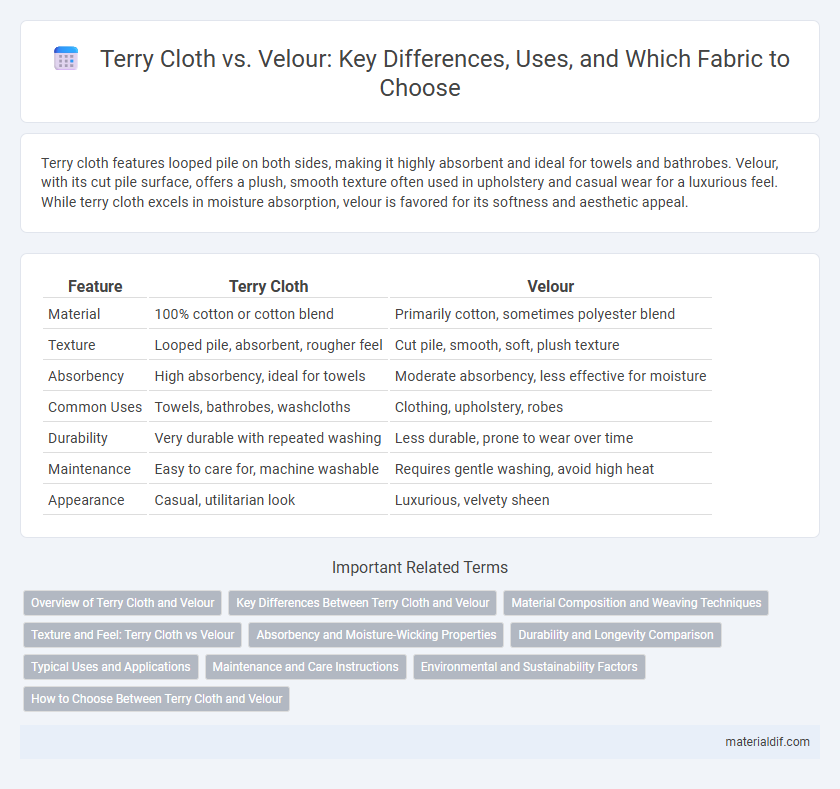Terry cloth features looped pile on both sides, making it highly absorbent and ideal for towels and bathrobes. Velour, with its cut pile surface, offers a plush, smooth texture often used in upholstery and casual wear for a luxurious feel. While terry cloth excels in moisture absorption, velour is favored for its softness and aesthetic appeal.
Table of Comparison
| Feature | Terry Cloth | Velour |
|---|---|---|
| Material | 100% cotton or cotton blend | Primarily cotton, sometimes polyester blend |
| Texture | Looped pile, absorbent, rougher feel | Cut pile, smooth, soft, plush texture |
| Absorbency | High absorbency, ideal for towels | Moderate absorbency, less effective for moisture |
| Common Uses | Towels, bathrobes, washcloths | Clothing, upholstery, robes |
| Durability | Very durable with repeated washing | Less durable, prone to wear over time |
| Maintenance | Easy to care for, machine washable | Requires gentle washing, avoid high heat |
| Appearance | Casual, utilitarian look | Luxurious, velvety sheen |
Overview of Terry Cloth and Velour
Terry cloth is a highly absorbent fabric characterized by its looped pile, commonly used in towels and bathrobes for effective moisture wicking. Velour features a plush, soft texture with a cut pile surface, often utilized in upholstery and clothing for its luxurious feel and smooth appearance. Both fabrics are made from cotton or cotton blends but serve different purposes due to their distinct textures and absorbency levels.
Key Differences Between Terry Cloth and Velour
Terry cloth features looped pile fabric in both warp and weft, providing high absorbency ideal for towels and bathrobes, while velour has a cut pile on one side, offering a smooth, plush texture suited for upholstery and loungewear. Terry cloth generally has a heavier weight and greater breathability due to its looped construction, whereas velour appears glossier with a velvety feel but less moisture absorption. The manufacturing processes differ, with terry cloth woven on special looms creating loops, and velour produced by shearing woven or knit fabric to raise the pile, influencing their distinct tactile and functional properties.
Material Composition and Weaving Techniques
Terry cloth is typically made from 100% cotton or a cotton-polyester blend, featuring a looped pile weave that enhances absorbency and softness, making it ideal for towels and bathrobes. Velour, often composed of cotton or synthetic fibers like polyester, employs a cut pile weave that creates a plush, velvet-like surface with a smooth texture, commonly used in upholstery and clothing. The key difference lies in terry cloth's looped pile designed for moisture absorption, whereas velour's cut pile focuses on visual richness and softness.
Texture and Feel: Terry Cloth vs Velour
Terry cloth features a looped pile texture, providing a highly absorbent and slightly rough feel ideal for towels and bathrobes. Velour, on the other hand, offers a smooth, plush surface with a dense, soft nap that resembles velvet, making it perfect for luxurious loungewear and upholstery. The distinct textures of terry cloth and velour influence their tactile experience, with terry emphasizing functionality and durability, while velour prioritizes softness and elegance.
Absorbency and Moisture-Wicking Properties
Terry cloth features a looped pile designed to enhance absorbency, making it highly effective for towels and bathrobes that require rapid moisture absorption. Velour, with its cut-pile surface, offers a softer feel but generally has lower absorbency and moisture-wicking capabilities compared to terry cloth. Fabrics used for quick-drying applications prefer terry cloth due to its superior ability to trap and release moisture efficiently.
Durability and Longevity Comparison
Terry cloth, woven with looped fibers, offers superior durability and resistance to wear, making it ideal for heavy use and frequent washing. Velour, characterized by its dense, plush pile, provides a softer feel but is generally less durable and prone to faster wear over time. The longevity of terry cloth outperforms velour due to its robust structure and ability to maintain texture through repeated laundering.
Typical Uses and Applications
Terry cloth is commonly used in towels, bathrobes, and sportswear due to its high absorbency and textured loops that provide excellent moisture-wicking properties. Velour, characterized by its soft, plush surface, is typically found in upholstery, loungewear, and luxury garments, offering a smooth, velvety feel suitable for decorative and comfort-focused applications. Both fabrics serve distinct roles: terry cloth excels in moisture management while velour emphasizes softness and aesthetic appeal.
Maintenance and Care Instructions
Terry cloth requires regular washing with mild detergent and avoiding fabric softeners to maintain its absorbency and texture, while Velour benefits from gentle machine washing on a delicate cycle and air drying to preserve its plush pile and vibrant colors. Terry cloth may need occasional ironing on low heat to remove wrinkles, whereas Velour should not be ironed as heat can crush the fabric's soft texture. Both fabrics require prompt drying to prevent mildew, but Velour demands extra care to avoid stretching or snagging its smooth surface during maintenance.
Environmental and Sustainability Factors
Terry cloth, made from 100% cotton, offers superior biodegradability and natural fiber sourcing, making it a more eco-friendly option compared to velour, which is often composed of polyester or synthetic blends derived from petrochemicals. The production of terry cloth generally consumes less energy and water, and it biodegrades faster in landfills, reducing long-term environmental impact. Velour's synthetic fibers contribute to microplastic pollution and require more intensive chemical processes, posing greater challenges for sustainability and recyclability.
How to Choose Between Terry Cloth and Velour
Choosing between terry cloth and velour depends on the desired texture and absorbency; terry cloth features looped pile fabric ideal for towels due to its superior moisture absorption, while velour offers a smooth, plush surface favored for comfortable clothing and upholstery. Consider terry cloth for items requiring durability and high absorbency, such as bathrobes and towels, whereas velour suits applications needing softness and a luxurious feel like loungewear and decorative cushions. The decision hinges on balancing functional needs against tactile preferences in fabric performance and appearance.
Terry cloth vs Velour Infographic

 materialdif.com
materialdif.com